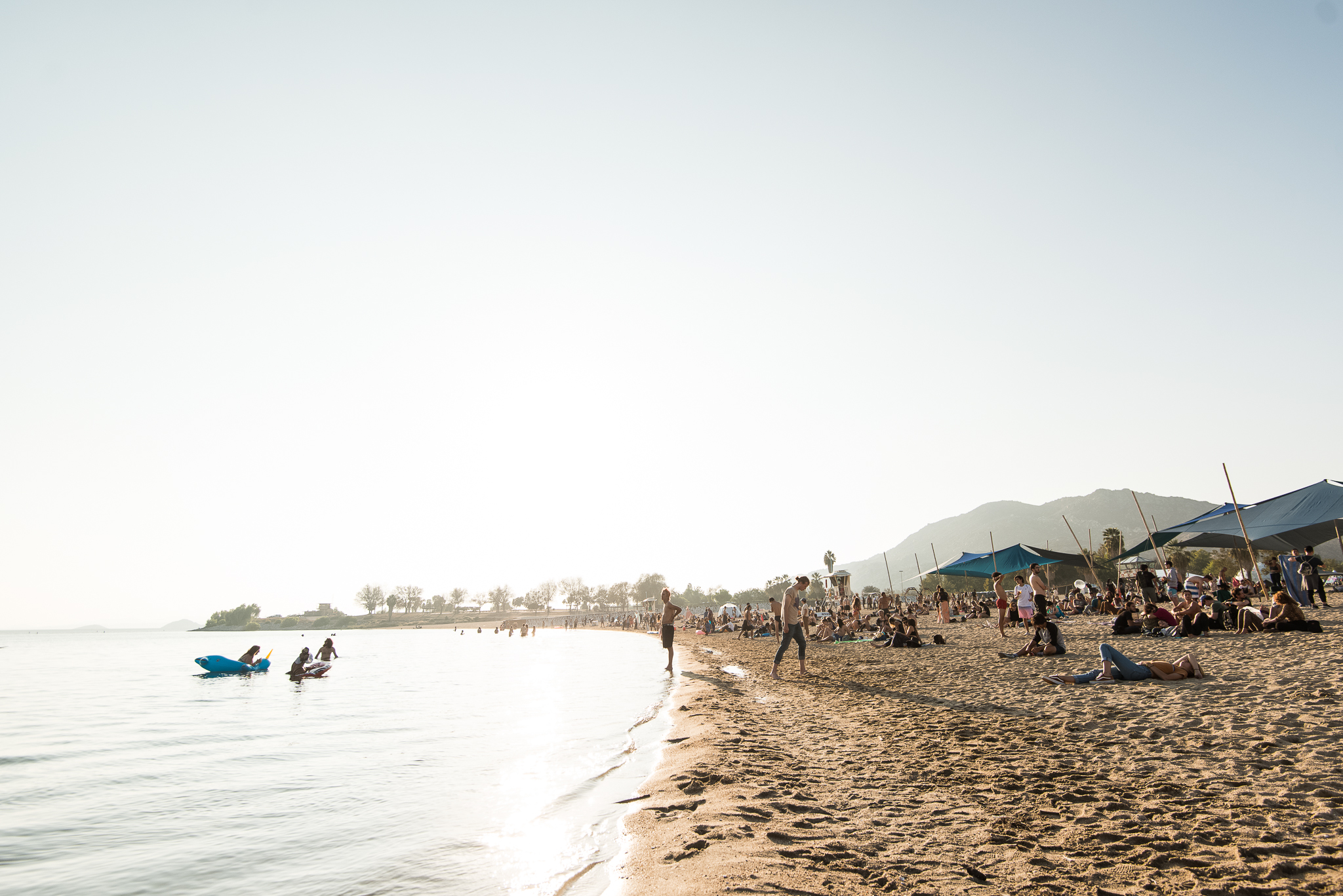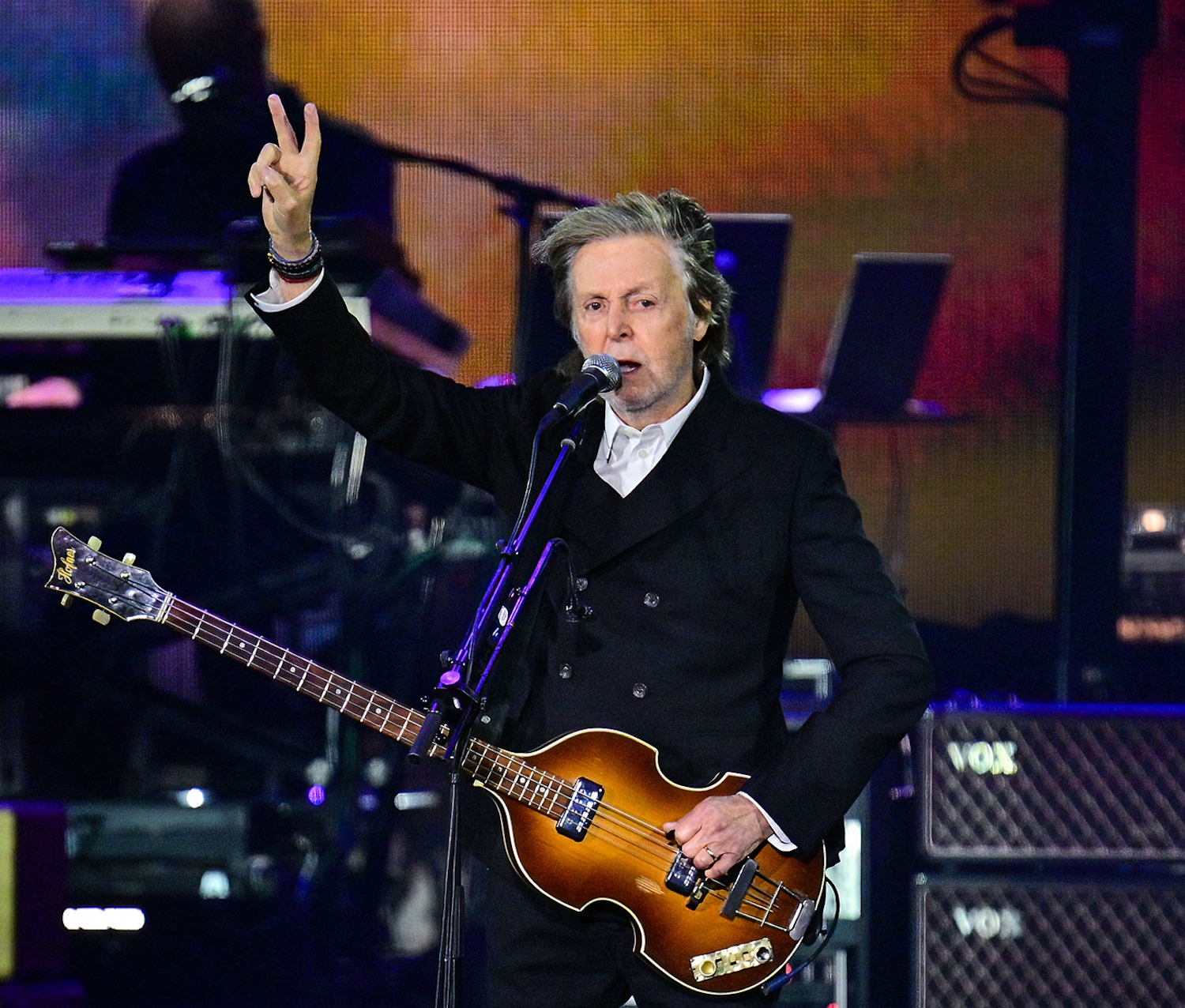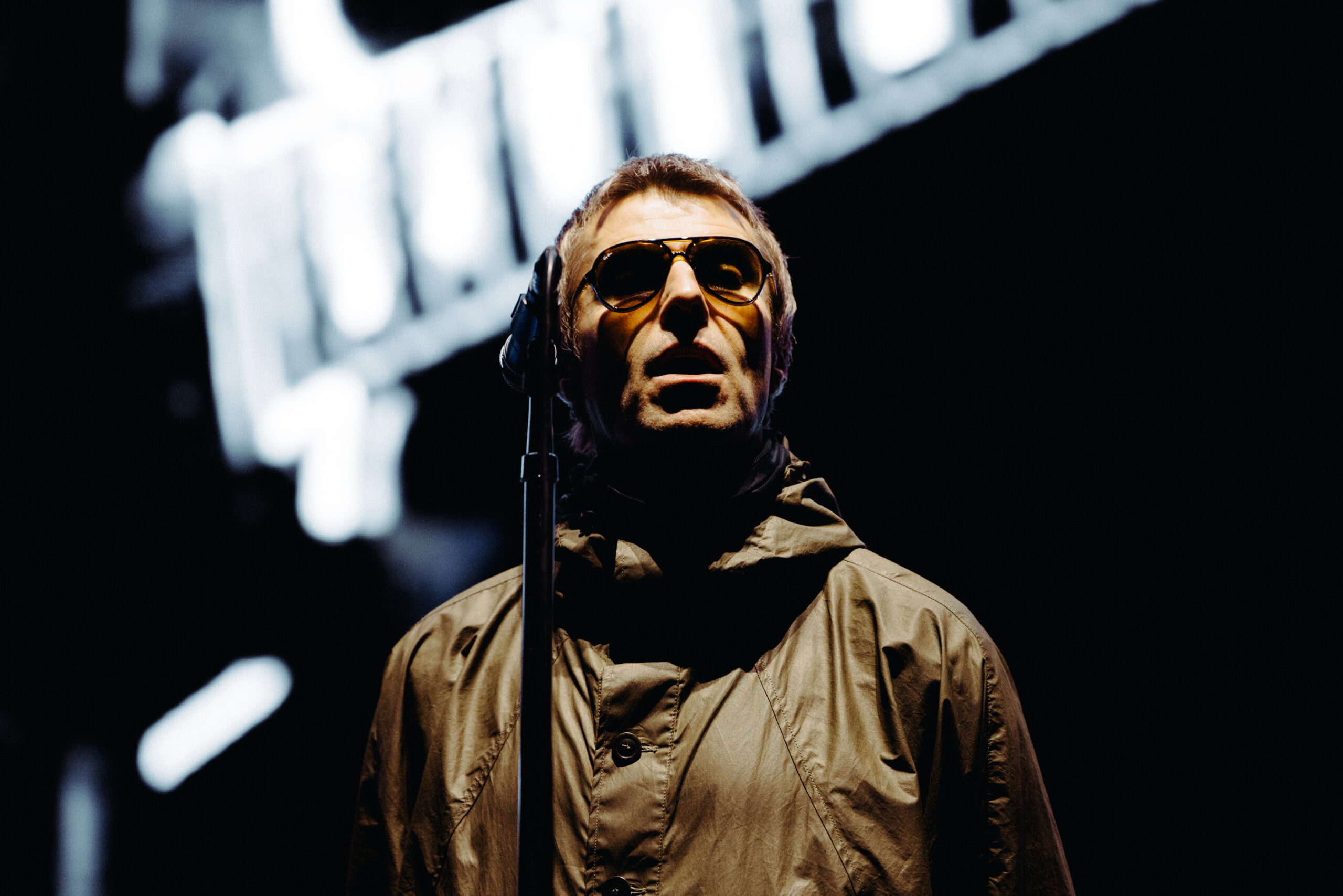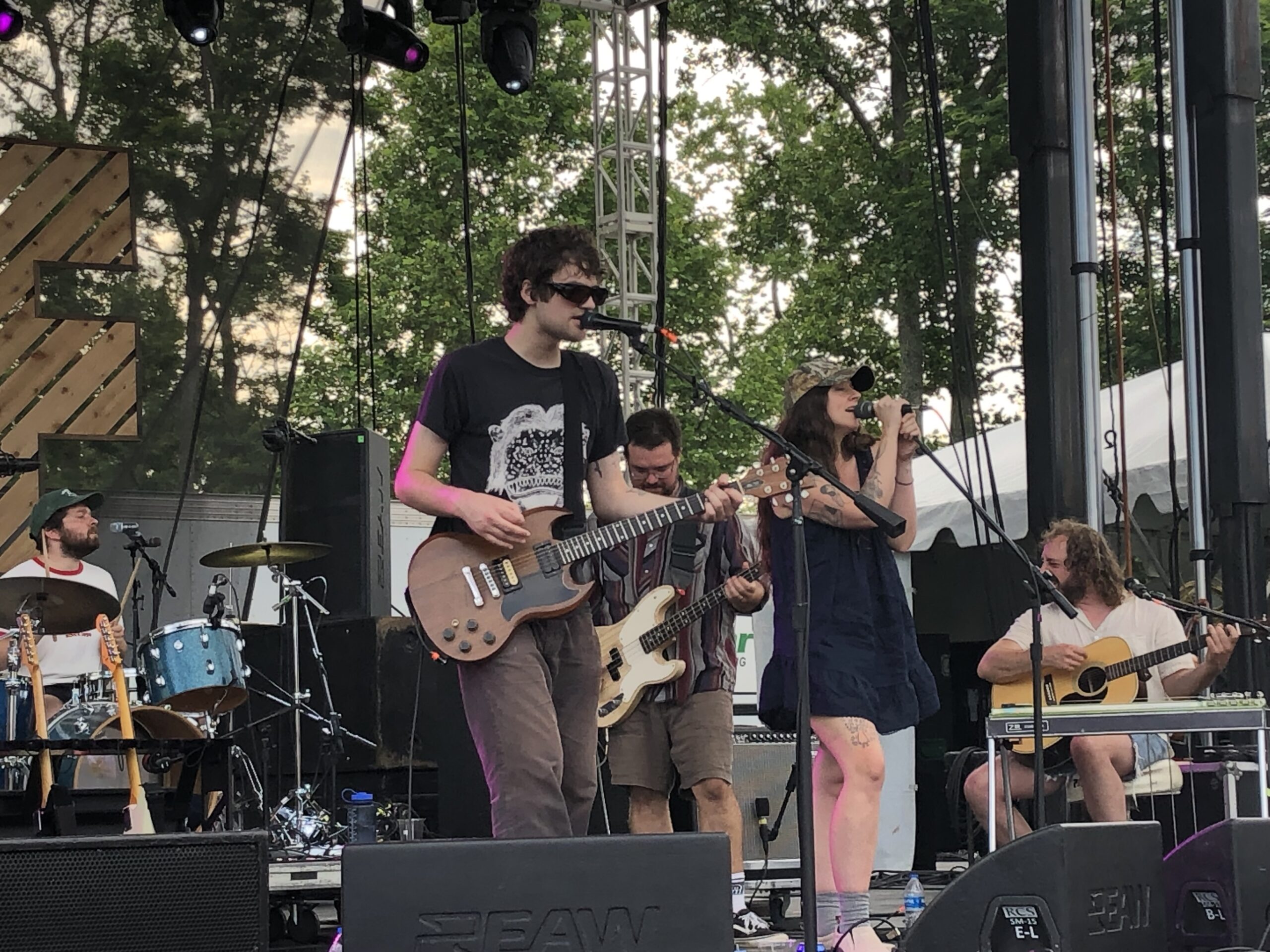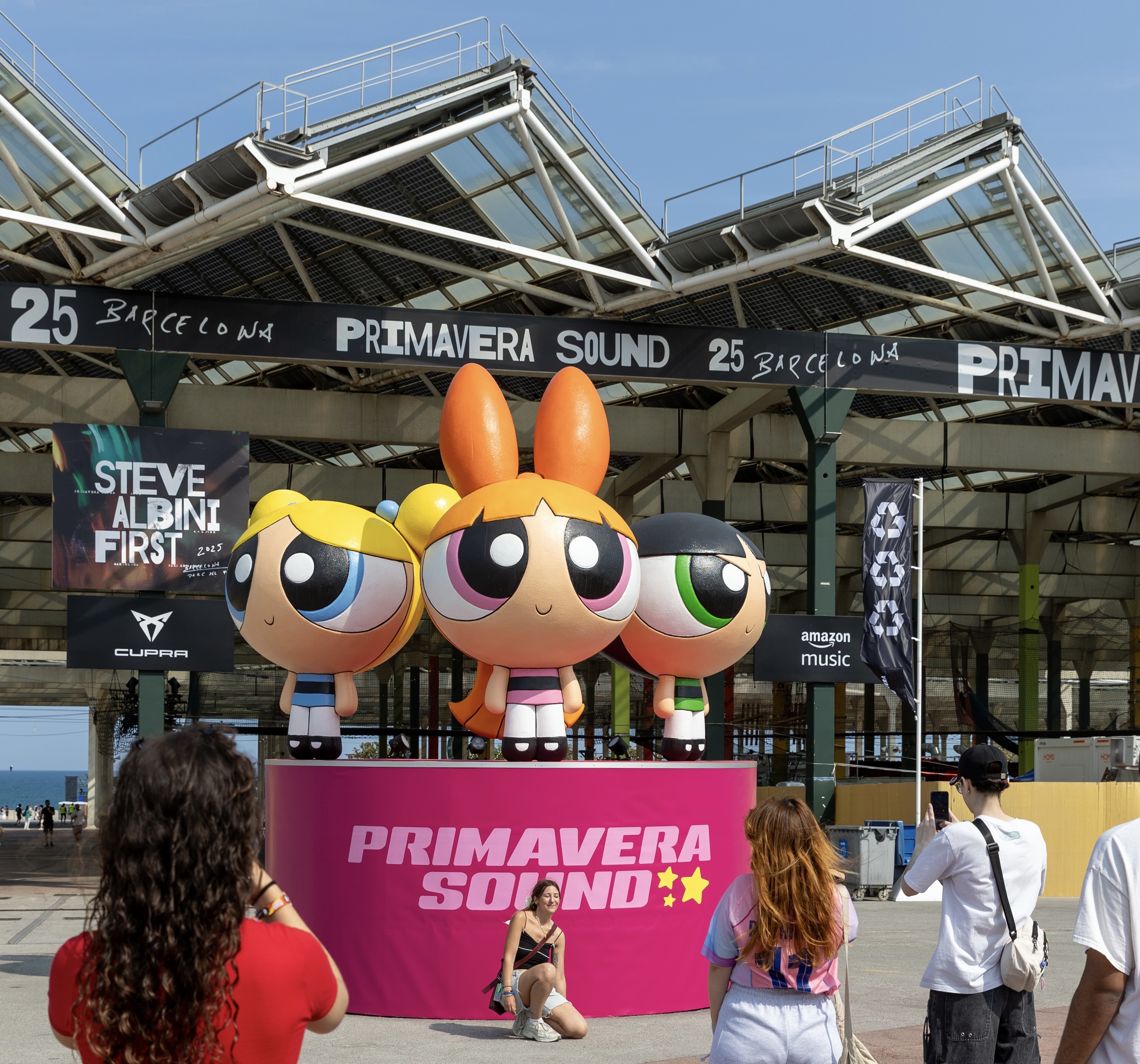For years now, Desert Daze has arrived in October like a mirage in the landscape to which it owes its name. It's a sudden oasis, where psych-rock bands and artists and stoners and adventurous music fans have gathered, culminating in what founder (and JJUUJJUU leader) Phil Pirrone has deemed an “anti-festival.” And while Desert Daze might have some of the familiar trappings and production values of a typical mainstream American festival, Pirrone's assertion isn't far off. In the over-crowded festival market these days, in which so many of the bigger-name US festivals race to a sort of crowd-pleasing attempt in the middle, Desert Daze is the rare example that has fervently and stubbornly carved out a specific identity all its own.
In its seventh iteration, Desert Daze found itself in a new location, and it's the first time you can't quite say it's in the desert. Previously taking place in Joshua Tree, Desert Daze had outgrown its original grounds and moved to Moreno Beach on Lake Perris, just about 20 or 30 min from Riverside, CA. The setting is, frankly, incredible. Rather than a giant park in a city or a nondescript field in whatever state, the new Desert Daze unfolded on a beach, with people being allowed to swim in the water, and mountains in the distance in either direction. It was idyllic, the sort of transporting circumstances most festivals wish for. Within that space, all the mutated noises of Desert Daze's lineup were able to grow more and more massive, until they could feel as if they were emanating from the lake and mountains themselves.
As for the festival layout, Desert Daze has remained a smaller, more navigable situation than many of its counterparts. There are just three primary stages, a mid-sized mainstage, a tinier outdoor stage, and a tent. It didn't take long to traverse the distance between any of them, and on your way you'd be likely to come across all sorts of jewelry and art shops in the marketplace, or any number of surreal art installations dotting the beach. Sure, this is still a festival in 2018, but even the Instagram traps at Desert Daze were genuinely cool. (Favorites seemed to include a rainbow that lit up at night, a square tunnel that bathed people in different colors, a spaceship/treehouse thing with asteroids or whatever hanging from it, and a small glass tower that emitted noise and had rings of light around the outside of it.)
[photoembed id="2018813" size="full_width" alignment="center" text=""]
In the tradition of festivals that look back to earlier psychedelic and hippie-ish days, Desert Daze had a whole lot of people camping right near the site, and there were all sorts of other things that popped up there, too. There was a tent called the Mystic Bazaar, in which artists sometimes played late-late-night sets or people showed up to lead all manner of events, from straight-up meditations to lesser-expected things like “cacao ceremonies.” Nearby, there were makeshift vendors and pedicab drivers that would ferry people down to the main grounds; one of the former promised “hair readings,” some kind of spiritually driven haircut experience.
All of this felt earnest where, say, the presence of raging college bros at Bonnaroo makes its claim to some counterculture past occasionally dissonant. Desert Daze isn't making any real concessions to market pressures, and as a result it boasts another uncommon quality of American festivals today: Its crowd has a very singular vibe to it, without anyone getting obnoxious. It was a genuinely open, laid-back atmosphere, where all anyone was really concerned about was finding some music to transform them.
In terms of its curation, Desert Daze is obviously a psychedelic festival. But that doesn't mean it is limited to retro-leaning guitar acts exhuming the '60s and '70s. When those appear, they're often the right choices, but there was also a whole lot of room for other sounds. The only prerequisite factor, the only unifying characteristic, is that the transcendence promised in psychedelic music could be found in so many different places. It isn't a stretch to say that if Desert Daze is putting forward a notion beyond a good weekend of music, it's exploring all the different things “psychedelic music” can mean today. Over the course of the weekend, there was droning heaviness, there were aqueous guitars made barely recognizable as guitars, there was languid folk, there was propulsive krautrock and punk, there was enveloping noise. Initially, Desert Daze's first day was off to a good start. There was a mixture of logical choices -- Pond's watery psych-rock, Warpaint's elusive take on the same thing -- and artists who approached outlier status, like Hinds' boisterous set and Jarvis Cocker. It's been years since Cocker has been in the mix consistently, and there was something stirring in seeing him back onstage at all, leaning on highlights from his 2006 solo debut Jarvis and new material with a group billed as Jarv Is. Much of the new music was artsy pop and rock more akin to Jarvis than to the garage-tinged Further Complications; one song featured such characteristic Cocker writing as “In the days of VHS and casual sex.” There was also something cathartic in seeing him play a song like “Cunts Are Still Running The World” -- now rechristened as “Pricks Are Still Running The World” in order to translate better internationally -- in 2018. That set the stage perfectly for Idles' set, a performance as raw and fervent as the hype has suggested. But during Idles, you could also see lightning emphatically flashing across the sky farther out over the lake. And as Tame Impala's big headlining set approached, so too did the rain and lightning. The band came onstage 15 minutes late; at first it appeared as if they would call off their set before it began. Instead, they did arrive and play a couple songs -- including a triumphant “Let It Happen” complete with confetti canons -- but were cut short right before an announcement that the grounds were to be evacuated. The storm was bad enough that Desert Daze had to cancel the rest of Friday night; for a festival that has so much going on past midnight, it was a noticeable loss.
It was also noticeable given that Tame Impala were easily one of the biggest names on the bill, and one of the only headliners offering more of a party set than say, the zone-out bliss of Slowdive. On Saturday, with rain still persisting in the afternoon, it was temporarily unclear what the second day's fate would be. Considering it's never supposed to rain in Southern California, this was all rather unexpected: It's one thing to lose a day of Lollapalooza or Governor's Ball to summer thunderstorms, but the storm that rolled over Desert Daze was a surprise blow. The festival rebounded well. After the rain, Saturday was pleasantly cool; on Sunday, it was warm enough that people could lounge on the beach and swim in the lake while, say, the sinuous melodies of Bedouine echoed out from the main stage. With some reshuffling necessitated by Friday night, Saturday became a crowded schedule full of disparate options. Cut Worms' old-school '60s sounds, Mercury Rev offering a vibrant performance of Deserter's Songs, JJUUJJUU's throbbing and heaving psychedelia, Cosmonauts' surging and swirling Brit-rock, Chelsea Wolfe's spaced-out gothiness, Kikagaku Moyo's classicist stoner rock. Maybe it's the specificity of Desert Daze's audience, but King Gizzard & The Lizard Wizard were the big-name headliners, and their set incited a giant moshpit. Before them, Slowdive took over the main stage, and the promises that were only hinted at during Friday's truncated schedule became clear: Hearing songs like “Star Roving” and “Souvlaki Space Station” reverberate out over a beach, the shadows of mountains in the distance receding into the night sky, is about as perfect a festival experience you can ask for. [photoembed id="2018811" size="full_width" alignment="center" text=""] Similarly, Sunday veered between the experimental orchestrations of Julia Holter, Sextile's groove-driven set, the rambunctiousness of Goon, a more brooding take on psychedelia thanks to Preoccupations' layered post-punk, long strung-out expanses from Earth, the festival's rare moment of unbridled intensity courtesy of Death Grips, and endless riffs from Earthless. But more so than on any other day of Desert Daze, it felt as if all roads were leading to a particular place. Their name had been whispered throughout the weekend, first-timers wondering if the legends could be true; there were rumors about the main stage being designed to their exact requirements. So when My Bloody Valentine arrived on Sunday night, it felt elemental. I had seen My Bloody Valentine once before, and it was recent. Before that, I'd heard those legends: that they played so incredibly loudly it made people lose control of their bodily functions or vomit, regardless of whether or not they'd also consumed some kind of substance. That you absolutely have to wear earplugs or you're risking serious damage. That they stretched out their closer with a ferocious, neverending wall of noise so overwhelming some people finally submitted and left early. The first time I saw them, I could see traces of these stories, but none of it matched the severity of what I'd been told. Their set at Desert Daze, however, did.A post shared by Scott Lapatine (@scottgum) on
Another great performance by #mybloodyvalentine #desertdaze
A post shared by G Sedillo (@circusinmyhead) on
Over the course of their set — which ran a bit late at about an hour and 40 minutes — you could move around the beach and take in MBV's performance in a handful of completely different ways. With earplugs in, you could walk through the crowd and feel MBV's music as a low, volcanic rumble effecting your ribcage more than your ears. You could walk far to the back of the of the main stage area and watch it like a distant warzone, aggressively trippy images flashing faraway in the dark amidst squalls and bombs. You could stand along the beach and hear the music echo out into the natural surroundings, waves of screeching noise as if the wind itself was screaming. And if you were particularly daring (or dumb), you could walk right up to the front of the stage, stand under the speakers, turn down the free earplugs that the festival employees were handing out up there, and totally succumb to the heaving cloud of “Soon” or “Only Shallow” combusting right in front of you. If you chose the latter, there's a good chance you wouldn't be able to hear the next day. But you might've also seen God. MBV's headlining set underscored an important aspect of Desert Daze. As used to shoegaze as we are, these shows are still way more experimental than we give them credit for, given the size and stature of the band. And how far removed is this from the pernicious stereotypes of a hippie psych-rock fest? There is nothing noodle-y or chill about a My Bloody Valentine set. It is physically assaulting, psychologically disorienting, and spiritually cleansing. Maybe it wasn't for everyone to the same extent that Tame Impala would've been. But there was something about their presence that felt more important at a festival like Desert Daze. That night, it was about pushing boundaries, grazing the outer limits. One would imagine that, in today's concert-going climate, there is not a sound business plan behind a festival with a curated point of view like Desert Daze's. One would also imagine that business isn't really on the minds of the people who run this thing. If it continues to grow, there is a likely scenario in which Desert Daze would have to adapt, to let go of some of its looseness and accessibility or to book bigger draws. Hopefully, it doesn't depart too far if/when that day comes. Right now, Desert Daze is in a perfect spot -- big enough to corral a seriously impressive lineup, small enough that it brings in people who are all enthusiastically engaging with a wide array of music. Its name might be a slight misnomer now. But the mystic escape that was always suggested there — that's something Desert Daze 2018 conjured perfectly. [photoembed id="2018814" size="full_width" alignment="center" text=""]
